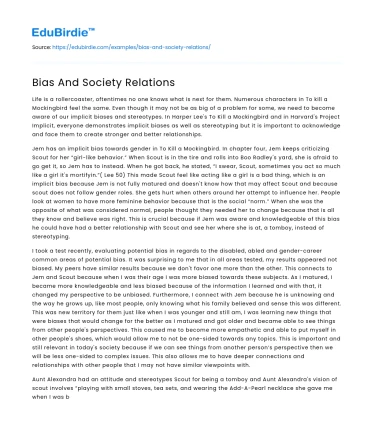Life is a rollercoaster, oftentimes no one knows what is next for them. Numerous characters in To kill a Mockingbird feel the same. Even though it may not be as big of a problem for some, we need to become aware of our implicit biases and stereotypes. In Harper Lee's To Kill a Mockingbird and in Harvard's Project Implicit, everyone demonstrates implicit biases as well as stereotyping but it is important to acknowledge and face them to create stronger and better relationships.
Jem has an implicit bias towards gender in To Kill a Mockingbird. In chapter four, Jem keeps criticizing Scout for her “girl-like behavior.” When Scout is in the tire and rolls into Boo Radley's yard, she is afraid to go get it, so Jem has to instead. When he got back, he stated, “I swear, Scout, sometimes you act so much like a girl it's mortifyin.”( Lee 50) This made Scout feel like acting like a girl is a bad thing, which is an implicit bias because Jem is not fully matured and doesn't know how that may affect Scout and because scout does not follow gender roles. She gets hurt when others around her attempt to influence her. People look at women to have more feminine behavior because that is the social “norm.” When she was the opposite of what was considered normal, people thought they needed her to change because that is all they know and believe was right. This is crucial because if Jem was aware and knowledgeable of this bias he could have had a better relationship with Scout and see her where she is at, a tomboy, instead of stereotyping.
Save your time!
We can take care of your essay
- Proper editing and formatting
- Free revision, title page, and bibliography
- Flexible prices and money-back guarantee
I took a test recently, evaluating potential bias in regards to the disabled, abled and gender-career common areas of potential bias. It was surprising to me that in all areas tested, my results appeared not biased. My peers have similar results because we don't favor one more than the other. This connects to Jem and Scout because when I was their age I was more biased towards these subjects. As I matured, I became more knowledgeable and less biased because of the information I learned and with that, it changed my perspective to be unbiased. Furthermore, I connect with Jem because he is unknowing and the way he grows up, like most people, only knowing what his family believed and sense this was different. This was new territory for them just like when I was younger and still am, I was learning new things that were biases that would change for the better as I matured and got older and became able to see things from other people's perspectives. This caused me to become more empathetic and able to put myself in other people's shoes, which would allow me to not be one-sided towards any topics. This is important and still relevant in today's society because if we can see things from another person’s perspective then we will be less one-sided to complex issues. This also allows me to have deeper connections and relationships with other people that I may not have similar viewpoints with.
Aunt Alexandra had an attitude and stereotypes Scout for being a tomboy and Aunt Alexandra's vision of scout involves “playing with small stoves, tea sets, and wearing the Add-A-Pearl necklace she gave me when I was born furthermore I should be a ray of sunshine in my father's lonely life.”(Lee 74) Aunt Alexandra clearly thinks this is how a girl should be and what she should do, thus implicitly stereotyping her and making scout follow gender norms. This is of great importance because if Aunt Alexandra could be more understanding and intentional with her relationship with Scout she could strengthen that relationship. This is important no matter who the relationship is with because in order to create those stronger relationships we need to face and address our implicit bias. If were able to accomplish this we will have better relationships with other people and we can learn to be more understanding to others which would allow for less issues and conflicts and a society that can deal with these issues all while having those strong and healthy relations
In conclusion, we all have biases whether we know it or not. Therefore, besides becoming aware, learning to understand and overcome our biases in order to have better, stronger as well as deeper relationships with other people. In order to do this we need to meet people where they are at, such as Jem accepting Scout where she is and for who she is and being understanding of our stereotypes rather than trying to make others understand our own view of things. If we start doing this our relations with others would prove creating a stronger connection and a less bias society.






 Stuck on your essay?
Stuck on your essay?

